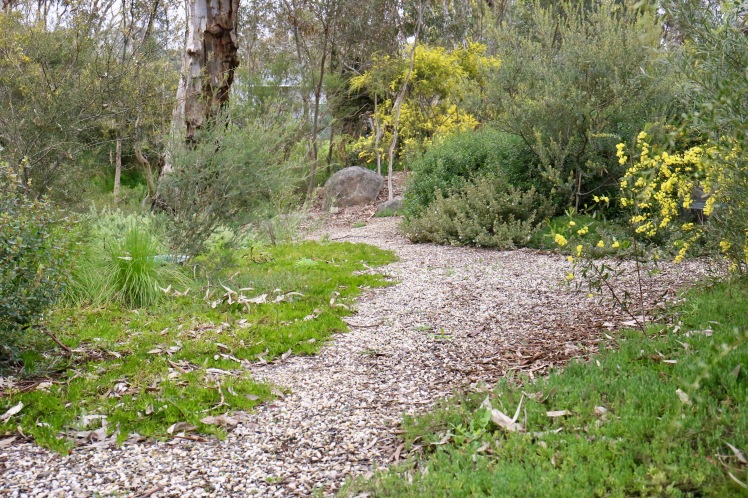There’s no doubt that rainfall shapes all wild plant communities. Drive west across Victoria, from wet forests in the Alps to arid Mallee in the State’s north-west, and you witness dramatic changes in the height, leafiness and composition of vegetation. Whether you look in a National Park or a weedy abandoned urban block, you will find plants thriving in their local conditions, whatever the rainfall. Part of the secret of plant survival in low rainfall areas is that each plant is part of a community and not an isolated individual
What can we learn from dryland plant communities that can be applied to our own gardens to ensure they thrive with minimal watering and effort? Read on to found out.
Keeping water where you want it
When rain falls, it can travel in three directions: back to the sky (evaporation), across the surface of the ground to stormwater or a creek (run-off), or deep into the soil (infiltration). Understanding how the vertical and horizontal structure of plant community’s influences water movement, will help you minimises water loss from your garden and maximise the number of plants your local rainfall can support.

Patchy plantings capture cross-country flow
In arid plant communities, you will often find patches of vegetation with high infiltration, surrounded by bare areas with few plants and low infiltration. These bare areas provide a source of run-off, which feeds extra water to patches of plants. Replicating this horizontal structure in your garden will help you concentrate rainfall where plants can use it.
Use impermeable surfaces, such as driveways, pathways or bare compacted ground, as a resource to steer rainfall into your garden beds. Mulched and planted garden beds allow water to filter into the soil where it becomes a reserve that plants roots can access.
Make it leafier to reduce evaporation
Vegetation layering is an almost universal quality of wild plant communities and a valuable tool for the sustainable gardener. In general, forests and woodlands have distinct layers of trees, shrubs and ground covers. Think of each leaf as a tiny parasol shading the ground: the leafier the plant community, the cooler the ground and the less evaporation. It’s true that plants also cause water to be lost to the atmosphere (by transpiration), but at least this lost water has been used to keep plants alive, rather than going back to the sky with nothing gained.
Are there hot-spots in your garden where you could squeeze another good-looking shrub to keep that soil cool?
Make the most of soil stored water
There are as many different root lengths as canopy heights. This allows different species in a community to access water at different depths in the soil. Ask yourself, how many layers can you fit in one garden bed without extra watering? Can you grow some shallow rooted ground covers under that lonely, deep-rooted tree?
Take a tip from natural plant communities. Grow patches of multi-layered plantings, and you may be surprised by how many more plants you can squeeze into one patch, with no extra watering required.
Article by Cassia Read, first published in ‘The Watering Can,’ Western Water’s garden e-news, Summer 2018.
hi Again, me again.
I so love how you have applied the ecologists mind to the home garden. Tongway’s landscape function analysis, I loved reading about this, magical some how the wisdom inherent in how nature does things. crazy how humans have disregarded this practical wisdom, and look at the destruction it has wrought.
you have a real skill in making landscape function alive and understandable for the average joe and flo. helping people to again listen to nature and observe the function art of her ways.
I have been creating project in critical biolink zone between cobaw range and macedon, I have been shocked by the reality on the ground, but also inspired by natures’ resilience, if only we give her a chance. the whole idea of country, waterways being private property’ has always challenged me. looking forward to working with he communities in the area to change attitudes and practice. found a little neglected parks vic reserve on the creekline, discovered in my surveys private landholders had chopped it up with fencing. worse still a wealthy landholder has been allowed ‘no one can really stop this’ to construct a tall deer fence around his place. hardly the best infrastructure to put in a critical biolink area!
anyway, I am ranting as usual sorry.
I am gradually going to connect with more urban landcare groups and see if we cant get your articles and the ideas in the spreading a bit further where they can do maximum good.
lost of love,
Tim
>
LikeLike